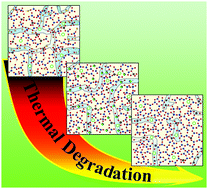Suppressing the thermal degradation of bismuth near-infrared luminescence in optical amorphous materials via topologically polymerized network structures
Abstract
Bismuth (Bi)-doped laser materials have emerged as an attractive gain medium for the development of a new generation of fiber lasers and optical amplifiers because of their superior broadband near-infrared (NIR) luminescence covering the entire optical communication window. For their practical applications, the thermal response of laser materials should be considered. However, to the best of our knowledge, Bi NIR emission usually involves severe thermal degradation due to the easy conversion between various Bi species. In this study, we have investigated the thermal degradation properties of Bi NIR emission in the Al2O3–GeO2 glass system with different compositions and interpreted their dependencies in terms of their microscopic topological network structure. As a result, thermal degradation was entirely suppressed via a polymerized glass network structure. The addition of Li2O caused a serious thermal degradation of Bi NIR emission along with the depolymerization of the glass network structure, as revealed by the Fourier-transform infrared (FTIR) and 27Al nuclear magnetic resonance (NMR) spectra. When Mg ions replaced Li ions, thermal degradation efficiently weakened. This may be attributed to the fact that depolymerization was significantly suppressed by introducing Mg–O– into the network structure units. In order to prevent the depolymerization of the glass network structure, we introduced trace amounts of Bi2O3 as both network modifiers and active ions in the glass system. Correspondingly, the thermal degradation of Bi NIR emission was completely inhibited. This study resolves the problem of thermal degradation of Bi NIR emission in glasses, and it can facilitate the design of Bi-doped laser glasses with stable luminescence properties and for the fabrication of fibers in the future.



 Please wait while we load your content...
Please wait while we load your content...